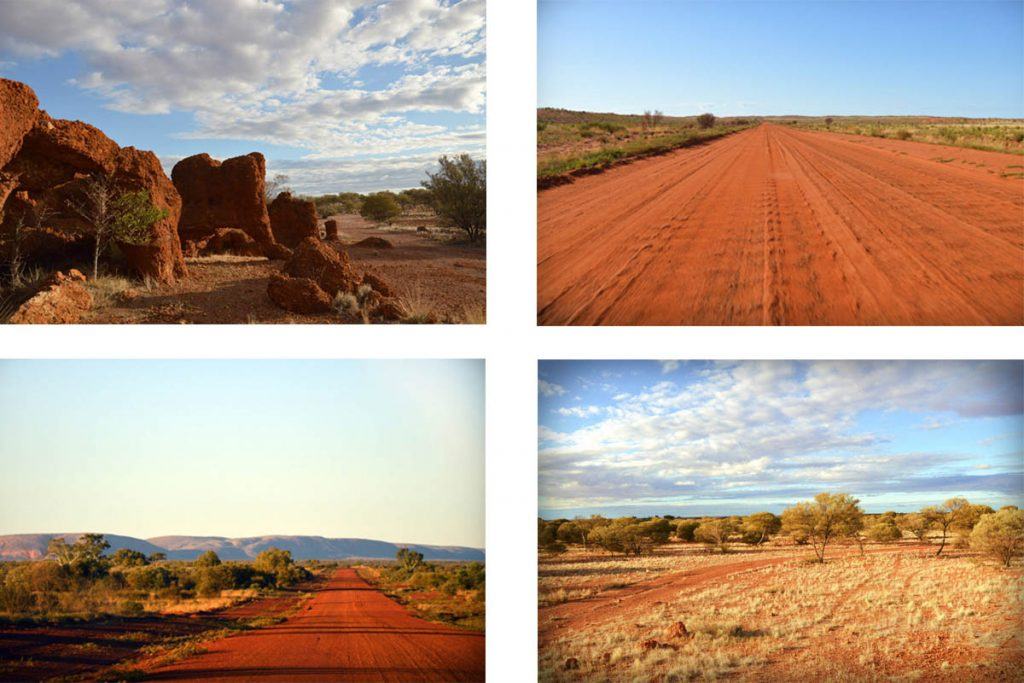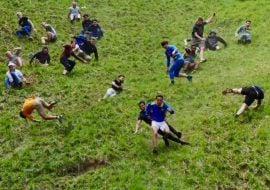Off Road Through The Desert: The Great Central Road, Australia


4×4 On The Great Central Road, Australia
The Great Central Road is a red and angry unsealed road that crosses the heart of Australia. It winds for 1098km of corrugated red dirt through the Gibson and the Great Victoria Desert. It is the western stretch of the so called Outback Way, the long shortcut that crosses Australia for 2700km, most of which on dirt roads, linking Queensland and Western Australia.
I’ve driven on this track with my partner in on a ’92 4WD Mitsubishi Delica and, against all odds and every prediction of locals, family members, mechanics and even random people: we did it! The Delica shook us safely in the heart of the Northern Territory without even a puncture! Here are some reasons of why you should consider the trip if you’re into exploring the great outdoors and a few tips on how to gear up and get ready to go.
It’s Australia’s longest shortcut
If you want to reach Ayers Rock from Perth, the GCR is 1000km shorter than the sealed option via Port Augusta and the Stuart Highway. A real shortcut that allows you to save plenty of time and gas but most of all: it’s a great adventure!
 Photo Credit: Sabrina Trevisan
Photo Credit: Sabrina Trevisan
Experiencing desert driving and camping
Driving and sleeping in the desert is an experience that every adventurous traveller should do at least once in a lifetime. The desert is not always dunes and desolation. The Gibson Desert and the Great Victoria Desert are actually a long stretch of arid and rocky land that fade from rusty red to sandy brown.
The landscape is dotted with patches of bush and the odd Gumtree, the Australian omnipresent eucalyptus tree. The constant adrenaline from paying attention to each slight car noise and road conditions is balanced by the chill nights around a bonfire, drinking beer under a million stars.
 Photo Credit: Sabrina Trevisan
Photo Credit: Sabrina Trevisan
Crossing paths with the Central Deserts Aboriginal
On the GCR, you will drive past many side tracks that lead to nearby Aboriginal communities. The road it’s mostly on their land, which is why you need a transit permit and you’re not allowed to stay more than three days or to leave the main road.
During the journey, it’s not rare to meet Aborigines families. You can find them sitting under the trees in one of the three roadhouses of the GCR, giving their radiator a break. They usually travel on old Land Cruisers overloaded with stuff, people and dogs. As soon as you spot them, they can quickly disappear in a cloud of dust on barely visible tracks in the middle of nowhere. A part from waving hello on the road, there’s no real contact with them. The communities can only be accessed with a specific permit and, in these remote areas, they rarely speak English.
Spotting incredible wildlife
In the desert, you can also have some fun encounters with the local fauna. In our three days trip we found a pretty rare thorny devil and a pack of wild camels.
Fun fact: feral camels are a thing in Central Australia!
They have been brought there during the exploration period of the 19th century and then set free when they were no longer needed. The camels loved the environment so much that they multiplied very fast, until reaching the scary threshold of one million in 2008. At that point, the government took action and reduced the population down to 300,000 animals. Nonetheless, you still have plenty of chances to meet them in the GCR.
 Photo Credit: Sabrina Trevisan
Photo Credit: Sabrina Trevisan
Reaching Ayers Rock and the Olgas from the back road
After three days of desert driving, the emotion of spotting the red and rounded peaks of The Olgas (aka Kata Tjuta) is beyond words. Coming from days of flat landscape, the grandeur of these domed rocks raising in the middle of nowhere is stunning. Plus, if you enter the National Park from the GCR you don’t have to pay the entrance fee, which probably is a fair reward for having crossed two deserts to get there.
 Photo Credit: Sabrina Trevisan
Photo Credit: Sabrina Trevisan
And now let’s clear some of the most asked questions about how to embark on this adventure and what gear is necessary.
Is it safe to take the Great Central Road without a 4WD?
The Great Central Road is not extremely challenging per se, but remoteness, length, road conditions and weather can make a huge difference. The hundreds of car wrecks rusting on the side of the road are there to testify that it’s no joke.
I met people that drove there with a normal car, but most of them were planning to get rid of it anyway. If you’re taking the road in the dry season, you probably won’t need to use the four wheels driving mode (we didn’t). But still, the road conditions can get pretty rough in some stretches (especially in the Northern Territory) so having a high clearance vehicle will get you through the worst corrugations swiftly and without causing damage to the car.
 Photo Credit: Sabrina Trevisan
Photo Credit: Sabrina Trevisan
When to go?
April to October is the best time to take the GCR. In the remaining months, rain can be an issue. I know that the concept of rain in the desert can seem a countersense, but it can actually rain heavily there and, without many trees to or grass to absorb water, flash floods are very common.
What is the necessary gear?
We brought with us two spare wheels, a tyre repair kit with a 12volt mini compressor, a towing rope, a shovel and jumper cables. A visit to the mechanic is also necessary before leaving, especially if you’re driving an old vehicle.
Check the condition of the tyres and make sure that they have the right pressure to drive on corrugated tracks. At the time, we didn’t have any GPS and we relied on HEMA Maps. Not that you can really get lost, but a GPS would be of great use in case you have a serious problem (forget to use your phone there).
 Photo Credit: Sabrina Trevisan
Photo Credit: Sabrina Trevisan
What if my car breaks down on the Great Central Road?
To be so remote, the GCR is actually well travelled. If your car breaks down, someone will probably pass by in a few hours. If you cannot fix the problem on the spot and you can’t contact your road assurance company, your only option is to be towed to the nearest roadhouse where, in exchange for a ginormous amount of money, they will try to fix the problem.
How many litres of water and fuel will I need?
Unleaded petrol or unleaded substitute (OPAL) and diesel are available at roadhouses about 250-350km apart. Most are open during daylight hours only. LPG is only available at Yulara and Alice Springs. It is recommended to carry sufficient fuel to travel at least 500-600km, but it is better to stock in advance: on the GCR fuel can get as expensive as $2.50/L.
To be on the safe (and on the cheap) side we stocked up in Laverton with 25L of water, 8L of beer, and 130L of diesel (full tank + four 20L jerry cans).
I hope that this will inspire you to get adventurous and eventually cross Australia through its central deserts as well!
More info here.
Last updated on Mar 31, 2021Have you subscribed to our Newsletter or Podcast? Listen to us on Apple Podcast and Spotify and follow us on Facebook, Instagram Twitter and YouTube.








